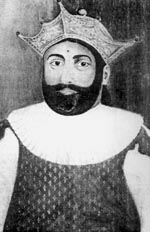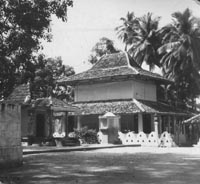 King Sri Wickrema Raja Sinha |
by Derrick Schokman
 King Sri Wickrema Raja Sinha |
On February 18, 1815 Sri Wickrema Raja Sinha, the Last King of Kandy was captured by Eknaligoda one of his chieftains and handed over to the British. The king had been hiding in the house of a subordinate Headman, one mile away from Meda Maha Nuwara which the kings used as a safe house during foreign invasions.
On the order of Governor Robert Brownrigg, the king and his party were kept under house arrest in Colombo until January 24 of the following year, prior to being banished aboard HMS Cornwallis to Fort Vellore, Madras.
Together with his four wives, mother, brother-in-law, other dependants and attendants, the king lived in exile in the fort for 16 years until his death in 1832 at the age of fifty two.
Brutality
What caused the final collapse of 2357 years of royal rule? It is generally agreed that the King’s brutality bordering on lunacy was the major cause.
He was responsible for the execution of First Adigar Pilimatalawa who had sponsored his kingship, and two Buddhist Priests of high order.
He had Adigar Ehelapola’s children butchered and his wife drowned in the Bogambara lake. He had 100 Headmen impaled for refusing on principle to do voluntary service (rajakariya) on the construction of the new lake.
He confiscated much land and property.
God-King
 Gangarama Temple, Kandy in 1815 |
Sri Wickrema Raja Sinha also seemed to be obsessed with a sort of god-king mentality. Some historians think that he had plans to convert Kandy into another legendary Alakamandawa with the Udawathakelle hill posing as the Himalayan Mount Meru and the new lake as the Kiri Muhuda. In fact, the 1815 maps of Kandy had the lake labelled as Kiri Muhuda. His other aspiration in this direction, which was foiled, included the building of a magnificent pavilion and pleasure garden in the sacred Devasangkinda or land within the four devales. The British, who were in control of the maritime regions, took advantage of the mounting indignation of the people against the king to infiltrate the Kandyan kingdom and make a deal with the dissident chieftains.
Doyle
John Doyle played a major role in this ploy. He was a prototype of the later more publicised Lawrence of Arabia and ‘Glub Pasha’.
He came to Sri Lanka in 1801 and devoted himself to mastering the Sinhalese language. After a short spell of training in Colombo he was appointed Revenue Collector and stationed at Matara.
His rapport with the language and culture of the country had an extraordinary influence on the people he came in contact with. It helped him win the cooperation of the Colombo and Matara mudaliyars to meet the disgruntled Kandyan chieftans and plan the surrender of Kandy, which was achieved without a shot being fired or the loss of single soldier.
For his part in this bloodless victory Doyle was made a knight of the Garter and raised to the rank of Resident Representative of the Governor and First Commissioner of the Board of Commission to administer the Kandyan provinces. He held this office until his early death in 1824 at the age of forty-nine. He was buried in the garrison cemetery - Kandy’s “Little England” where eminent Britishers were interred in the early years of colonial government.
172nd death anniversary of Sri Wickrema Rajasinha. Jan 30:The fall of the Kandyan Kingdom in 1815
by Aryadasa Ratnasinghe - DN Sat Jan 29 2005
"Beware of Ehelepola and Molligoda. They are deceivers and double tongued traitors. They deceived me and will deceive you too. They are hostile to each other in their struggle for power".
|
|
So said Sri Wickrema Rajasinha (1780-1832), the last king of Kandy, when he was captured by the British troops to be deported to Vellore in South India, where he died on January 30, 1832, afflicted with dropsy (mass accumulation of watery fluid in the body).
In Vellore, the royal family occupied the palatial mansion of Tippu Sahib, the Sultan of Mysore, the son of Hyder Ali, the Muslim ruler of Mysore, where they lived for 17 years. Up to 1890, the Sri Lanka government offered a grant to the family members, which was later converted to a land grant from the village Mysore.
The king, during his childhood days, was known as prince Kannasamy of Dravidian descent, a Hindu by religion, and belonged to the Jentu royal clan of the Nayakkar dynasty of South India, who were Malabaris.
Although he did not aspire to become king, he was, by circumstances, compelled to wear the crown, by the most intriguing, ambitious and deceitful Maha Adikaram Pilimatalawwe, who had his secret plans to dethrone the Malabari king, whose predecessors ruled the island for 76 years. The last Sinhalese king was Vira Parakrama Narendrasinha (1706-1739).
Pilimatalawwe Wijeyesundera Rajakaruna Seneviratne Abayakoon Panditha Mudiyanse was the Maha Adikaram from 1790 to 1811. He was a very powerful chief, second in name to the king, but not in power. In craft and ambition, he was second to none.
Thus by birth, family, power and wit, he was the best fitted to hold the reigns of state, next to the king, and there was none to dispute.
The king had his fears that his benefactor, the Maha Adikaram, would one day ascend the throne. Wrapped in selfishness, possessed of ungovernable passions, destitute of feelings, either human or divine, and without moral principles, he turned out to be a perfect tyrant and a despot.
Nobody can repress a shudder at the atrocities of Sri Wickrema Rajasinha, who ordered a mother (Ehelepola Kumarihamy), to take her infant, and pound it to death in a mortar with a pestle.
She had four children. One was Loku Banda (11 years), the second was Madduma Banda (9 years), the third was Podi Menika (5 years) and the last was Dingiri Menika (2 years). The last was at the breast, and when the head was severed from the body, the milk it had drunk trickled out with blood.
This incident happened on the Vesak poya day, on May 23, 1814, and mentioned in a despatch by D.Oyly, the Resident of Kandy, the governor Sir Robert Brownrigg (vide Ceylon Literary Register, Vol. IV). The massacre was done at the Wal Bodiya, where the Diyawadana Nilame, (Mullegama Nilame,) read out the law, that in the absence of the traitor, his family could be punished.
The father of the king was Venkata Perumal, the Chief Priest ('Pandaram') of the Rameswaram Jyothirlinga Hindu temple in the Gulf of Mannar. It is said that it was built by Rama (one of the ten 'avatars' of god Vishnu) and Hanuman (the Monkey King).
The temple had derived its name from Rama, who had installed the Jyothirlinga of god Siva or Iswera, the third god-head of the 'Trimoorti' (the Hindu Divine Triad).
The temple is a superb construction, 667 ft. in length and 1,000 ft. in width (667,000 sq.ft. in area), with a tiled roof 20 ft. high, and a 'gopura' (pandal) 100 ft. high, which adorns the entrance.
The wife of Venkata Perumal was Subbamma, the younger sister of Upendramma, and consort of king Rajadhi Rajasinha (1747-1780) of Kandy.
When prince Kannasamy was 7 years his father died, and the queen Upendramma, invited her to come to Sri Lanka with her son.
On arrival, they were accommodated in a house at Malabar Street (now Kumararuppe Vidiya in Kandy), exclusively meant for the kith and kin of the royal family. No one was allowed to enter the place other than the Maha Adikaram Pilimatalawwe.
The Maha Adikaram, in the course of time, began to operate his nefarious plan to dethrone the king, and appoint prince Kannasamy as successor to the throne, with the intent and purpose of gaining the throne to himself when the time comes.
It proved to be a success, and the prince ascended the throne at the young age of 17 years, in the name of Sri Wickrema Rajasinha, and the ceremony was held within the precincts of Natha Devale in Kandy.
The prince received his primary education from Ven. Kobbekaduwe Siri Nivasa Maha Thera and from the Ven. Anu-nayake Moratota Dhammakhanda thera of the Pushparamaya (now Malwatte).
When the Maha Adikaram consulted the Maha Thera, over his plan to enthrone the prince, the advice received was, "Such a one as you contemplate, will attend to advice and tractable at first, but since his education is no good, your plan will fail. He will follow his own bent. The country will suffer and your life will be at stake".
It did happen as foretold, when the Maha Adikaram Pilimatalawwe was beheaded for high treason, for conniving with the British to gain power, on August 28, 1811, on an unanimous verdict of the royal court, in the presence of Dehigama, Kapuwatta, Angammana, Galegoda, Dunuville, Mullegama, Unamboowe, Doolewa and Ratwatte, who were 'Nilames' of high rank.
With the death of Pilimatalawwe, Ehelepola Wijayasundera Wickremasinghe Chandrasekera Amarakoon Wasala Mudyanse succeeded to the vacancy of Maha Adikaram in 1812. The king now became more suspicious and tyrannical than before.
Terrified by the past, apprehensive of future danger and intent on his own security only, regardless of consequences, he took every precautionary action which he deemed fit. The people were dissatisfied with the king's own bent, and most of them anticipated a change of government under the British rule.
According to Dr. Henry Marshall, Inspector-General of Army Hospital, "the king possessed an aristocratic appearance hardly found among men. He was 5ft. 9 ins. tall, with an attractive beard and a moustache well trimmed to suit his round face.
He had broad shoulders, and a well proportionate body somewhat obese. He seldom laughed and always looked rough and moody.
He had roving eyes which turned red when in wrath."
When the British troops were on the hunt to arrest the king alive he left the palace and took shelter in the house of Bombure Appurala in Meda Mahanuwara, a few miles from Kandy. The British garrison including John D'Oyly, Thomas Hardy, Col. Hooke, Ehelepola Nilame, Pilimatalawwe Disawa (not the one beheaded) Thamby Mudali, Dias Abeysinha, the Interpreter, Ja Muhandiram, Ekneligoda, Kawdumune, Kurandumune, Thorawature, Delwala Mahawalatenne etc., left in search of the king.
These 'Nilames' and others, who went down their knees before the king, now became boisterous in the presence of the British troops. The king was brought to Colombo under escort and remained a prisoner, until he was, with his wives and others, were set sail to India.
They were deprived of the royal menu with rice and 32 curries, which formed the daily diet of the king. The vessel left Colombo on January 24, 1816, carrying the deportees. His queens were Venkata Jammal, Mutukannamma, Venkata Ammal and Nachiyar Ammal.
The queen Mutukannamma gave birth to a son at the Vellore camp, who was named Rajadhi Rajasinha. He married Savitridevi, but he died in 1842.
The cremation of the king was done with simple honours and the ashes, according to Hindu custom, were flowed down the river Parr. The cortege made its way to the cemetery amidst military honours with a large number of troops participating in the event.
There is a tomb erected by the relatives of the king, by the left bank of the river, which still stands.
Sri Wickrema Rajasinha turned out to be a despot due to the activities of his chiefs, most of whom tried to get rid of him, and gain the throne for the Sinhalese. Finally, he became a tyrant of the most wicked type, who killed everyone whom he suspected for high treason.